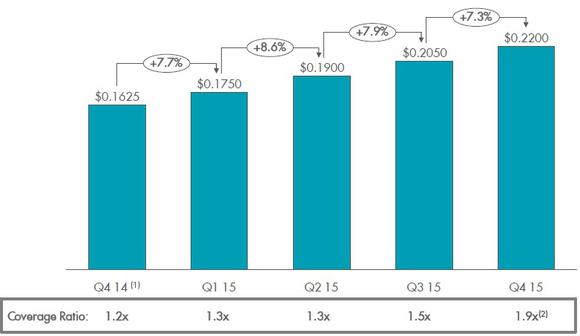
Source: Shell Midstream Partners.
Dividend investors might be surprised to find that not all energy dividends are suffering amid the worst oil crash in over 50 years.
SHLX Dividend data by YCharts
Shell Midstream Partners (NYSE: SHLX) has crushed the payout growth rate of the overall MLP industry, as well as the broad S&P 500, over the past year. It's even outperformed fellow midstream growth superstars such as Phillips 66 Partners (NYSE: PSXP), MPLX (NYSE: MPLX), and Valero Energy Partners (NYSE: VLP).
So what exactly is the key to Shell Midstream Partners' secret sauce of dividend growth greatness? Here's why I am confident that Shell Midstream Partners' superb payout growth could continue for the next decade or even beyond.
Quality assets and a strong sponsor
"In our initial public offering we launched the partnership with a flagship portfolio of high-quality assets in strategically advantaged locations. At that time, we told you that our dropdown strategy was to build on that portfolio with accretive fee-based assets, and we accomplished that by completing $1.2 billion of dropdowns."
-- John Hollowell, CEO, Shell Midstream Partners
The key to maintaining strong payout growth that's sustainable even during an oil crash is to insulate an MLP's distributable cash flow (DCF) from a connection to energy prices via long-term, fixed-fee contracts.
It's also important that a fast-growing midstream MLP have a sufficiently large potential dropdown pipeline from its sponsor. Here are how each of these refiner midstream MLPs' growth opportunities compare:
- Shell Midstream Partners: sufficient midstream drop down pipeline to increase annual EBITDA 17 fold compared to 2015.
- Phillips 66 Partners: $9 billion in new midstream project spending by Phillips 66, a projected 267% increase in EBITDA between 2015 and 2018.
- Valero Energy Partners: $715 million in eligible new midstream assets spending by Valero Energy in 2016 alone.
- MPLX: Backlog of growth projects and dropdowns worth potentially $33 billion.
All of these MLPs have plenty of growth opportunities available. However, Valero Energy Partners' investors need to remember a key difference regarding their MLP's growth runway. Valero Energy, while a large refiner, owns far fewer midstream assets than its larger peers -- Phillips 66, Marathon Petroleum, and Royal Dutch Shell. That means that its distribution growth may remain impressive for the next five years, but maintaining that pace beyond that might prove challenging.
Payout growth is just one important factor
| MLP | Forward Yield | 2015 Distribution Coverage Ratio (DCR) | 2015 Distribution Growth | Projected Annual Distribution Growth |
|---|---|---|---|---|
| Shell Midstream Partners | 2.4% | 1.65 | 34% | 28% |
| Phillips 66 Partners | 3% | 1.30 | 35% | 30% through 2018 |
| Valero Energy Partners | 2.7% | 2.06 | 20% | 24% |
| MPLX | 6.1% | 1.27 | 31% | 12% to 15% in 2016 |
Sources: Yahoo! Finance, earnings releases, earnings presentations, 10-Ks, management guidance, Fastgraphs.
Shell Midstream Partners' short track record of strong payout growth is notable not just for its large magnitude, but especially because it's distribution coverage ratio -- one of the most important long-term payout sustainability metrics -- has been growing steadily.

Source: Shell Midstream Partners.
Over its first year in existence, Shell Midstream Partners' has been retaining increasingly more cash flow, which can be used to fund further growth with less dependence on debt or equity markets. In this challenging energy environment that is an excellent competitive advantage to have.
However, as impressive as Shell Midstream's payout profile is, dividend lovers also need to consider one more thing.
Never forget to watch out for excessive debt
"We said we will maintain a conservative balance sheet throughout the year, and we did so by completing two equity offerings in May and November to partially fund the dropdowns. ... [O]ur ability to access the equity markets allowed us to stay well within our targeted leverage ratios and speaks to the quality of our asset base."
-- Hollowell, Q4 earnings call
As Kinder Morgan proved last year, management that's too focused on payout growth at the expense of balance-sheet health isn't doing investors any favors.
That's why I'm so pleased that Shell Midstream is willing to use its strong unit price as valuable currency to continue acquiring new assets, and being, at least thus far, less reliant on debt markets than its peers. For example, here is each MLP's debt-to-EBITDA, or leverage ratios:
- MPLX: 4.7
- Phillips 66 Partners: 4.4
- Valero Energy Partners: 2.5
- Shell Midstream Partners: 2.1
In fact, Shell Midstream just recently announced it was selling another 12.7 million that would raise around $400 million, potentially meaning another dropdown may be imminent. While true that the unit price is down significantly since its all time highs, (this secondary offering represents 13% dilution to existing unitholders), the money is very likely to mean that DCF per unit will still rise enough to continue strong payout growth for the rest of the year.
Risks to consider
While there's a lot to admire about Shell Midstream Partners, it only had its IPO about a year ago. That means more conservative investors might want to wait a few more quarters to make sure both management and Royal Dutch Shell prove to be wise stewards of unitholder capital.
In addition, a resumption of plunging oil prices could reduce its price enough to force increased borrowing. Thanks to its low debt levels even in this scenario Shell Midstream's growth prospects for 2016 will probably remain good. Only in the event that energy prices remain low for several years is the MLP likely to be unable to live up to its full growth potential.
Bottom line
Nothing in the energy sector is certain. However, given its massive drop down pipeline, strong balance sheet, and relatively strong access to equity capital markets, Shell Midstream has the potential to become one of the best dividend growth stocks of the next decade.

